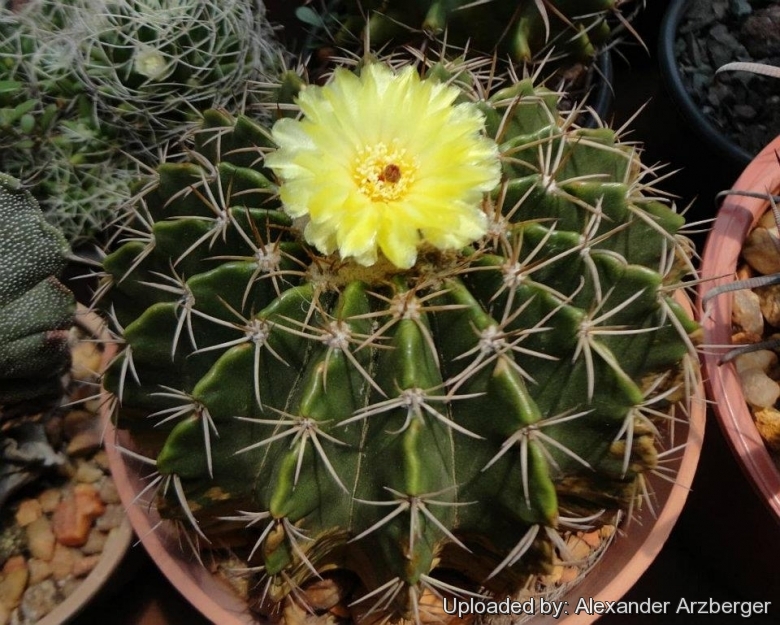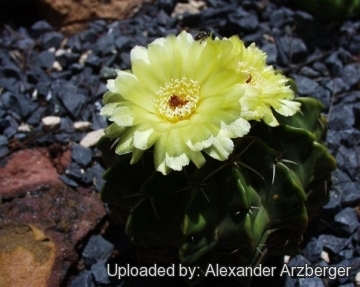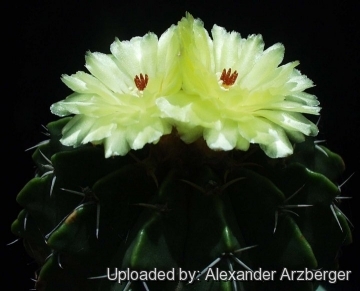Accepted Scientific Name: Parodia erinacea (Haw.) N.P.Taylor
Bradleya 5: 93 (1987)

Malacocarpus erinaceus (Parodia erinacea) Photo by: Alexander Arzberger
Origin and Habitat: Argentina (Buenos Aires, Córdoba, Entre Ríos, La Pampa, Rio Negro, San Luis, Santiago del Estero); Brazil (Rio Grande do Sul); Uruguay.
Altitude range: Up to 30 metres above sea level.
Habitat and Ecology: The species grows on rocky outcrops, in grasslands or pampas. Generation length is 10 years. The major threats are grazing and forestry. Illegal collection can potentially become a threat.It has a wide range, is locally abundant, and is present within protected areas. In Brazil and part of Uruguay, however, several subpopulations have been extirpated and the major threats continue to affect subpopulations.
Synonyms:
See all synonyms of Parodia erinacea
back
Accepted name in llifle Database:Parodia erinacea (Haw.) N.P.TaylorBradleya 5: 93 (1987)Synonymy: 28
back
Description: Parodia erinaceaSN|20203]]SN|20203]] is a simple, flattened-globular to short-cylindrical cactus, very woolly at top, the ribs are obtuse, strongly undulate with areoles in the depressions on ribs. The central spine is not much longer than the radials. The flowers are yellow broad when fully open with bright red stigma-lobes. It is a widespread and morphologically variable taxon. The young plants generally are very different from the more woolly, older individuals.
Stem: Plants solitary, light to dark green with a very woolly stem tip in older plants (often referred as pseudocephalium), depressed globose to globose (the largest part above-ground), or in age short cylindrical, to 15(-20) cm high, 6-30 cm in diameter.
Ribs: 12-15, in age 23-30, obtuse, sharply acute and distinct. Often oblique or undulate, transversally furrowed with increasing age, laterally compressed and thickened at the areoles.
Areoles: About 10 mm apart, born in the depressions on the notches on ribs, when young, covered by tufts of dirty white wool, up to 2 cm long which is only lost in age.
Spines: Awl shaped, straight to strongly curved, whitish, yellowish, grey or brown, subulate, 10-20 mm long.
Central spine: 0-1 straight, more or less pointing upwards, apex pinkish-brownish, sometimes grey with a brown tip, 14 mm long.
Radial: Spines 2-12, mostly 8, flattened against the stem surface, 3 of which smaller, fine, bristles-like, pointing upwards like the central spine. The remaining five stronger, 10-14 mm long, two of them paired on the sides, and the last median one, somewhat smaller, pointing downwards, but neither bent nor adpressed to the body.
Flowers: Glossy yellow, 3-5 cm long, 4-7 cm in diameter, broad when fully open, borne singly or 2-3 arising together from the stem apex. Pericarpels and floral tubes short, partly immersed in the densely wool stem apex. covered by dense brownish to almost black wool and narrow, rather pointed, green scales, darker at the tip, each with a brown bristle. Inner perianth segments straw yellow, silky, extremely glossy, spreading, oblong to spatulate, acute, often serrate above. Outer perianth segments heart-shaped, reddish at the edges, with dark curved tips, mostly bent outwards. Stamens bright yellow with whitish yellow anthers. Stigma-lobes approximately 10 bright red.
Fruits: Elongating when ripe, club shaped, at first greenish with sticky pulp and completely hidden in the woolly stem apex, later when mature pink or reddish, partly naked, dry and hollow, 5-7 mm thick, 2-3(-4) cm long, contain approximately 70-150 seeds..
*Seeds: Bell shaped, c. 1 mm, light brown to black, finely roughened.
Phenology: The flowers appear in summer, open in the late morning and close early in the afternoon, they are self-fertile. The fruits appear about after 4 months, or more commonly the year after fertilization.
Bibliography: Major references and further lectures
1) Larocca, J., Machado, M., Duarte, W. & Demaio, P. 2013. Parodia erinacea. The IUCN Red List of Threatened Species 2013: e.T152287A619140. http://dx.doi.org/10.2305/IUCN.UK.2013-1.RLTS.T152287A619140.en. Downloaded on 15 October 2016.
2) N. L. Britton, J. N. Rose “The Cactaceae. Descriptions and Illustrations of Plants of the Cactus Family.” Volume 3, The Carnegie Institution of Washington, Washington 1922.
3) Edward Anderson “The Cactus family” Timber Press, Incorporated, 2001
4) James Cullen, Sabina G. Knees, H. Suzanne Cubey "The European Garden Flora Flowering Plants: A Manual for the Identification of Plants Cultivated in Europe, Both Out-of-Doors and Under Glass" Cambridge University Press, 11/August /2011
5) David R Hunt; Nigel P Taylor; Graham Charles, International Cactaceae Systematics Group. "The New Cactus Lexicon" dh books, 2006
6) Haworth, A. H. (1819) "Cactus erinaceus - Supplementarum Plantarum Succulentarum", London S.74.
7) Krainz, H. (1966): KuaS 17 ( 10 ) :195.
8) Krainz (ed.), "Die Kakteen", Lfg. 35. f. 6C, 7 (1967) & Lfg. 53-54 (1973)
9) N. Gerloff & J. Neduchal "Taxonomische Neubearbeitung", Frankfurt 2004.
10) Hirao, "Colour encyclopaedia of cacti". f. 422-425 (1979)
11) Hecht, "BLV Handbuch der Kakteen". 336 (1982)
12) Cullmann et al., "Cacti", 253 (1986).
 Malacocarpus erinaceus (Parodia erinacea) Photo by: Alexander Arzberger
Malacocarpus erinaceus (Parodia erinacea) Photo by: Alexander Arzberger - An extremely variable species, the young plants generally very different from the more woolly, older individuals. (Parodia erinacea) Photo by: Alexander Arzberger
- An extremely variable species, the young plants generally very different from the more woolly, older individuals. (Parodia erinacea) Photo by: Alexander Arzberger Malacocarpus erinaceus (Parodia erinacea) Photo by: Alexander Arzberger
Malacocarpus erinaceus (Parodia erinacea) Photo by: Alexander ArzbergerSend a photo of this plant.The gallery now contains thousands of pictures, however it is possible to do even more. We are, of course, seeking photos of species not yet shown in the gallery but not only that, we are also looking for better pictures than those already present.
Read More... Cultivation and Propagation: It is easy to grow. They like a warm bright location, does great in partial shade avoid full sun. They need good drainage and prefer a neutral to slightly acidic compost with plenty of extra grit. Water and feed during the summer. Best if watered with rain water. Keep above 0°C and rather dry in winter, rot easily if the substrate is wet and cold, tends to lose its roots in winter.
Propagation: Seeds














